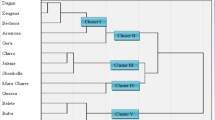Abstract
Powdery scab of potato, once established in a field, is difficult to control because of the longevity of the resting spores (cystosori) of the causal organism, Spongospora subterranea f.sp. subterranea. Host resistance is likely to be the most efficient in a long-term control strategy for preventing build-up of field inoculum and spread of the disease. Resistance screening of potato cultivars is mostly done in laborious field trials where disease development is likely to be unpredictable. A bioassay with potato tissue cultured plantlets and cystosori as inoculum is described and was tested for its potential to screen potato cultivars at an early stage for their relative susceptibility to powdery scab by comparing the lab results with field data. With cystosori inoculum of Swiss origin, the laboratory test showed clear differences between the potato cultivars in the severity of zoosporangial root infection which correlated better with ranked tuber infection data, compared to root galling. There are apparent differences in the relative trends in susceptibility between roots and tubers of five selected cultivars when using naturally infested soil instead of prepared cystosori as inoculum in the lab bioassay. Furthermore, differences in the severity of zoosporangial root infection of two selected cultivars were found when cystosori from different countries where used as inoculum. A possible host genotype × pathogen interaction is discussed. The bioassay has the potential to screen and select for resistant material at an early breeding stage thus making field trials not unnecessary but more economical. It will allow the use of a standard set of pathogen collections and facilitate testing for inoculum virulence in infested soils.
Similar content being viewed by others
References
Bell KS, Roberts J, Verrall S, Cullen DW, Williams NA, Harrison JG, Toth LK, Cooke DEL, Duncan JM and Claxton JR (1999) Detection and quantification of Spongospora subterranea f.sp. subterranea in soils and on tubers using specifique PCR primers. European Journal of Plant Pathology 105: 905-915
Bulman SR and Marshall JW (1998) Detection of Spongospora subterranea in potato tuber lesions using the polymerase chain reaction (PCR). Plant Pathology 47: 759-766
Bus CB (2000) Powdery scab control in the Netherlands. In: Merz U and Lees AK (eds) Proceedings of the First European Powdery Scab Workshop (pp 79-83)
Aberdeen, Scotland, July 20-22 (http://www.pa.ipw.agrl. ethz.ch/spongospora/EUworkshop/proceedings.html)
de Boer RF (1991) Evaluation of potato cultivars in the greenhouse and field for resistance to powdery scab. Australian Journal of Experimental Agriculture 31: 699-703
de Boer RF (2000) Research into the biology and control of powdery scab of potatoes in Australia. In: Merz U and Lees AK (eds) Proceedings of the First European Powdery Scab Workshop (pp 79-83) Aberdeen, Scotland, July 20-22
Falloon R, Genet R, Wallace A and Nott H (1999) IPM use for powdery scab. Commercial Grower 54(3): 33-34
Fornier N (1997) Epidemiology of Spongospora subterranea, the cause of powdery scab of potatoes. University of Aberdeen, Scotland, PhD thesis
Gans PT and Vaughan JE (2000) Cultivar susceptibility to powdery scab of potatoes, caused by Spongospora subterranea. In: Merz U and Lees AK (eds) Proceedings of the First European Powdery Scab Workshop (pp 39-41) 2000, Aberdeen, Scotland, July 20-22
Hughes IK (1980) Powdery scab (Spongospora subterranea) of potatoes in Queensland: Occurrence, cultivar susceptibility, time of infection, effect of soil pH, chemical control and temperature relations. Australian Journal of Experimental Agriculture and Animal Husbandry 20: 625-632
Jellis GJ, Phul PS and Starling NC (1987) Evaluation of potato germplasm for resistance to powdery scab (Spongospora subterranea). Annals of Applied Biology 110(Suppl 8): 154-155
Kirkham RP (1986) Screening for resistance to powdery scab disease of potatoes, Australian Journal of Experimental Agriculture 26: 245-247
Lees AK (2000) Resistance to powdery scab in potato. In: Merz U and Lees AK (eds) Proceedings of the First European Powdery Scab Workshop (pp 35-38) 2000, Aberdeen, Scotland, July 20-22
Mäkäräinen E, Rita H, Teperi E and Valkonen JPT (1994) Resistance to Spongospora subterranea in tuber-bearing and non tuber-bearing Solanum spp. Potato Research 37: 123-127
Merz U (1989) Infectivity, inoculum density and germination of Spongospora subterranea resting spores: A solution-culture test system. Bulletin OEPP 19: 585-592
Merz U (1993) Epidemiological aspects of powdery scab of potatoes caused by Spongospora subterranea. In: Hiruki Ch (ed) Proceedings of the 2nd Symposium of the International Working Group on Plant Viruses with Fungal Vectors (pp 104-106) 1993, Montreal, Canada, July 25-27
Merz U (2000) Powdery scab. Research in Switzerland. In: Merz U and Lees AK (eds) Proceedings of the First European Powdery Scab Workshop (pp 67-71) 2000, Aberdeen, Scotland, July 20-22
Schwärzel R (2002) Sensibilité des racines et tubercules des variétés de pommes de terre à la gale poudreuse et quelques résultats de lutte chimique. Revue Suisse d'Agriculture 34: 261-266
Wale SJ (2000) Summary of the session on national potato production and the powdery scab situation. In: Merz U and Lees AK (eds) Proceedings of the First European Powdery Scab Workshop (pp 3-9) 2000, Aberdeen, Scotland, July 20-22
Walsh JA, Merz U and Harrison JG (1996) Serological detection of spore balls of Spongospora subterranea and quantification in soil. Plant Pathology 45(5): 884-895
Wastie RL, Caligari PDS and Wale SJ (1988) Assessing the resistance of potatoes to powdery scab (Spongospora subterranea (Wallr.) Lagerh.). Potato Research 31: 167-171
Author information
Authors and Affiliations
Rights and permissions
About this article
Cite this article
Merz, U., Martinez, V. & Schwärzel, R. The potential for the Rapid Screening of Potato Cultivars (Solanum tuberosum) for Resistance to Powdery Scab (Spongospora subterranea) using a Laboratory Bioassay. European Journal of Plant Pathology 110, 71–77 (2004). https://doi.org/10.1023/B:EJPP.0000010123.21255.d1
Issue Date:
DOI: https://doi.org/10.1023/B:EJPP.0000010123.21255.d1




